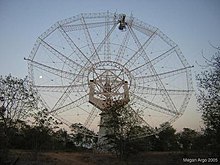거대 메트로웨이브 전파 망원경
Giant Metrewave Radio Telescope | |
| 대체 이름 | GMRT |
|---|---|
| 장소 | 인도 마하라슈트라 푸네 구 나라얀가온 |
| 좌표 | 19°05′47§ N 74°02′59§ E/19.096517°N 74.049742°E좌표: 19°05°47[N74°02]59 e E / 19.096517°N 74.049742/ 19.74. |
| 조직 | 국립전파천체물리학 |
| 파장 | 50, 1,500MHz(6.00, 0.20m) |
| 초광 | 1995년 |
| 망원경 스타일 | 포물선 반사체 무선 간섭계 |
| 망원경 수 | 30개 |
| 직경 | 45 m (8 인치 길이) |
| 집하 영역 | 47,7132 m (513,580 평방 피트) |
| 마운트 | 알타지무트 마운트 |
| 웹 사이트 | www |
| | |
인도 호다드 나라얀가온 인근 준나르 푸네 인근에 위치한 거대 포물선 전파망원경(GMRT)은 직경 45m의 30개의 완전 조종 가능한 포물선 전파망원경이다.이것은 뭄바이 타타 기초 연구소의 일부인 국립 전파 천체 물리학 센터(NCRA)에 의해 운영된다.그것은 고 교수님의 지시로 구상되고 건설되었다.1984년부터 [1]1996년까지 Govind Swarup 주지사.최대 25km(16mi)[2][3][4]의 기준선을 가진 간섭계 배열입니다.그것은 최근 업그레이드된 거대 메트로웨이브 전파 망원경으로 알려진 새로운 수신기로 업그레이드 되었다.
위치
GMRT 전망대는 푸네에서 북쪽으로 약 80km 떨어진 호다드에 위치해 있다.인근 마을은 나라얀가온으로 망원경에서 약 9km 떨어져 있다.NCRA 사무실은 Savitribai Phule Pune University 캠퍼스에 있습니다.
과학과 관찰
망원경의 개발 목적 중 하나는 원시 중성 수소 구름에서 21cm의 매우 붉은 색 편이가 심한 선 복사를 찾아 우주에서 [5][6][7][8][9][10][11][12][13][14][15][16][17][18][19][20][21][22][23][24][25][26][27][28]은하가 형성된 시기를 알아내는 것이었다.
전세계의 천문학자들은 정기적으로 이 망원경을 사용하여 HII 영역, 은하, 맥동, 초신성, 태양과 [2]태양풍과 같은 많은 다른 천체들을 관찰합니다.
2018년 8월 GMRT에 [29]의해 120억 광년 거리에 위치한 지금까지 알려진 가장 먼 은하가 발견되었다.
2020년 2월, 그것은 우주 역사상 가장 큰 폭발인 오피우쿠스 초은하단의 [30]폭발을 관측하는 데 도움을 주었다.
활동.
매년 국립과학의 날에, 천문대는 일반인과 주변 지역의 학교와 대학의 학생들을 초대하여, 그곳에서 일하는 기술자들과 천문학자들로부터 전파 천문학, 수신기 기술, 천문학에 대한 설명을 들을 수 있습니다.또한 인근 학교/대학에서도 각각의 과학실험을 전시하고 각 레벨의 최고(초등, 중등, 주니어 칼리지)가 수여됩니다.
방문객은 금요일 오전(1100시간 - 1300시간)과 저녁(1500시간 - 1700시간) 두 개의 세션에서만 GMRT에 입장할 수 있습니다.
「 」를 참조해 주세요.
레퍼런스
- ^ Govind Swarup 교수:인도 전파천문의 아버지
- ^ a b Ananthakrishnan, S. (1995). "The giant meterwave radio telescope" (PDF). Journal of Astrophysics and Astronomy. 16: 433. Retrieved 27 June 2015.
- ^ Ishwara-Chandra, C H; Rao, A Pramesh; Pandey, Mamta; Manchanda, R K; Durouchoux, Philippe (2005). "Low Frequency Radio Observations of GRS1915+105 with GMRT". Chinese Journal of Astronomy and Astrophysics. 5 (S1): 87–92. arXiv:astro-ph/0512061. Bibcode:2005ChJAS...5...87I. doi:10.1088/1009-9271/5/S1/87.
- ^ 스왈룹, G., 아난트크리슈난, S., 카파히, V.K., 라오, A.P., 수브라함마냐, C.R. 및 V.K. 쿨카니(1991) "거대 메트위브 전파망원경", 현재과학부, 60105쪽.
- ^ Kapahi, V. K.; Ananthakrishnan, S. (1995). "Astronomy with the giant metrewave radio telescope (GMRT)" (PDF). Bulletin of the Astronomical Society of India. 23: 267. Bibcode:1995BASI...23..265K. Retrieved 27 June 2015.
- ^ Bharadwaj, Somnath; Nath, Biman B.; Sethi, Shiv K. (1 March 2001). "Using HI to probe large scale structures at z~3". Journal of Astrophysics and Astronomy. 22 (1): 21–34. arXiv:astro-ph/0003200. Bibcode:2001JApA...22...21B. doi:10.1007/BF02933588. ISSN 0250-6335.
- ^ Bharadwaj, S.; Nath, B. B.; Sethi, S. K. (2002). "Probing Large Scale Structures in HI with GMRT". The Universe at Low Radio Frequencies. 199: 108. Bibcode:2002IAUS..199..108B. doi:10.1017/s0074180900168640.
- ^ Bharadwaj, Somnath; Sethi, Shiv K. (1 December 2001). "HI fluctuations at large redshifts: I-visibility correlation". Journal of Astrophysics and Astronomy. 22 (4): 293–307. arXiv:astro-ph/0203269. Bibcode:2001JApA...22..293B. doi:10.1007/BF02702273. ISSN 0973-7758.
- ^ Bharadwaj, Somnath; Pandey, Sanjay K. (1 March 2003). "HI Fluctuations at Large Redshifts: II - the Signal Expected for the GMRT". Journal of Astrophysics and Astronomy. 24 (1–2): 23–35. arXiv:astro-ph/0307303. Bibcode:2003JApA...24...23B. doi:10.1007/BF03012189. ISSN 0250-6335.
- ^ Bharadwaj, Somnath; Srikant, P. S. (1 March 2004). "HI Fluctuations at Large Redshifts: III - Simulating the Signal Expected at GMRT". Journal of Astrophysics and Astronomy. 25 (1–2): 67–80. arXiv:astro-ph/0402262. Bibcode:2004JApA...25...67B. doi:10.1007/BF02702289. ISSN 0250-6335.
- ^ Pandey, Sanjay K.; Bharadwaj, Somnath; Saiyad Ali, S. K. (11 February 2006). "Probing the bispectrum at high redshifts using 21-cm H i observations". Monthly Notices of the Royal Astronomical Society. 366 (1): 213–218. arXiv:astro-ph/0510118. doi:10.1111/j.1365-2966.2005.09847.x. ISSN 0035-8711.
- ^ Choudhury, T. Roy; Bharadwaj, Somnath; Datta, Kanan K. (1 December 2007). "Detecting ionized bubbles in redshifted 21-cm maps". Monthly Notices of the Royal Astronomical Society. 382 (2): 809–818. arXiv:astro-ph/0703677. Bibcode:2007MNRAS.382..809D. doi:10.1111/j.1365-2966.2007.12421.x. ISSN 0035-8711.
- ^ Chengalur, Jayaram N.; Bharadwaj, Somnath; Ali, Sk Saiyad (21 April 2008). "Foregrounds for redshifted 21-cm studies of reionization: Giant Meter Wave Radio Telescope 153-MHz observations". Monthly Notices of the Royal Astronomical Society. 385 (4): 2166–2174. arXiv:0801.2424. Bibcode:2008MNRAS.385.2166A. doi:10.1111/j.1365-2966.2008.12984.x. ISSN 0035-8711.
- ^ Choudhury, T. Roy; Bharadwaj, Somnath; Majumdar, Suman; Datta, Kanan K. (21 December 2008). "Simulating the impact of H i fluctuations on matched filter search for ionized bubbles in redshifted 21-cm maps". Monthly Notices of the Royal Astronomical Society. 391 (4): 1900–1912. arXiv:0805.1734. Bibcode:2008MNRAS.391.1900D. doi:10.1111/j.1365-2966.2008.14008.x. ISSN 0035-8711.
- ^ Choudhury, T. Roy; Bharadwaj, Somnath; Datta, Kanan K. (1 October 2009). "The optimal redshift for detecting ionized bubbles in Hi 21-cm maps". Monthly Notices of the Royal Astronomical Society: Letters. 399 (1): L132–L136. arXiv:0906.0360. Bibcode:2009MNRAS.399L.132D. doi:10.1111/j.1745-3933.2009.00739.x. ISSN 1745-3925.
- ^ Choudhury, T. Roy; Datta, Kanan K.; Bharadwaj, Somnath; Majumdar, Suman (11 May 2011). "The impact of anisotropy from finite light traveltime on detecting ionized bubbles in redshifted 21-cm maps". Monthly Notices of the Royal Astronomical Society. 413 (2): 1409–1418. arXiv:1006.0430. Bibcode:2011MNRAS.413.1409M. doi:10.1111/j.1365-2966.2011.18223.x. ISSN 0035-8711.
- ^ Ghosh, Abhik; Bharadwaj, Somnath; Ali, Sk. Saiyad; Chengalur, Jayaram N. (1 March 2011). "GMRT observation towards detecting the post-reionization 21-cm signal". Monthly Notices of the Royal Astronomical Society. 411 (4): 2426–2438. arXiv:1010.4489. Bibcode:2011MNRAS.411.2426G. doi:10.1111/j.1365-2966.2010.17853.x. ISSN 0035-8711.
- ^ Ghosh, Abhik; Bharadwaj, Somnath; Ali, Sk. Saiyad; Chengalur, Jayaram N. (1 December 2011). "Improved foreground removal in GMRT 610 MHz observations towards redshifted 21-cm tomography". Monthly Notices of the Royal Astronomical Society. 418 (4): 2584–2589. arXiv:1108.3707. Bibcode:2011MNRAS.418.2584G. doi:10.1111/j.1365-2966.2011.19649.x. ISSN 0035-8711.
- ^ Choudhury, T. Roy; Bharadwaj, Somnath; Majumdar, Suman (11 November 2012). "Constraining quasar and intergalactic medium properties through bubble detection in redshifted 21-cm maps". Monthly Notices of the Royal Astronomical Society. 426 (4): 3178–3194. arXiv:1111.6354. Bibcode:2012MNRAS.426.3178M. doi:10.1111/j.1365-2966.2012.21914.x. ISSN 0035-8711.
- ^ Chengalur, Jayaram N.; Ali, Sk Saiyad; Bharadwaj, Somnath; Prasad, Jayanti; Ghosh, Abhik (11 November 2012). "Characterizing foreground for redshifted 21 cm radiation: 150 MHz Giant Metrewave Radio Telescope observations". Monthly Notices of the Royal Astronomical Society. 426 (4): 3295–3314. arXiv:1208.1617. Bibcode:2012MNRAS.426.3295G. doi:10.1111/j.1365-2966.2012.21889.x. ISSN 0035-8711.
- ^ Ghosh, A.; Prasad, J.; Bharadwaj, S.; Ali, Sk. S.; Chengalur, J. N. (1 April 2013). "VizieR Online Data Catalog: Complete 150MHz GMRT source catalogue (Ghosh+, 2012)". VizieR On-line Data Catalog. 742. Bibcode:2013yCat..74263295G.
- ^ Ali, Sk Saiyad; Ghosh, Abhik; Bharadwaj, Somnath; Choudhuri, Samir (21 December 2014). "Visibility-based angular power spectrum estimation in low-frequency radio interferometric observations". Monthly Notices of the Royal Astronomical Society. 445 (4): 4351–4365. arXiv:1409.7789. Bibcode:2014MNRAS.445.4351C. doi:10.1093/mnras/stu2027. ISSN 0035-8711.
- ^ Choudhuri, Samir; Bharadwaj, Somnath; Ali, Sk. Saiyad (2014). "Foreground simulation and power spectrum estimation for 610 MHz GMRT observations". Astronomical Society of India Conference Series. 13: 315–317. Bibcode:2014ASInC..13..315C.
- ^ Ghosh, Abhik; Roy, Nirupam; Ali, Sk Saiyad; Chatterjee, Suman; Bharadwaj, Somnath; Choudhuri, Samir (21 December 2016). "The visibility-based tapered gridded estimator (TGE) for the redshifted 21-cm power spectrum". Monthly Notices of the Royal Astronomical Society. 463 (4): 4093–4107. arXiv:1609.01732. Bibcode:2016MNRAS.463.4093C. doi:10.1093/mnras/stw2254. ISSN 0035-8711.
- ^ Ali, Sk. Saiyad; Bharadwaj, Somnath; Choudhuri, Samir; Ghosh, Abhik; Roy, Nirupam (28 November 2016). "Prospects of Measuring the Angular Power Spectrum of the Diffuse Galactic Synchrotron Emission with SKA1 Low" (PDF). Journal of Astrophysics and Astronomy. 37 (4): 35. arXiv:1610.08184. Bibcode:2016JApA...37...35A. doi:10.1007/s12036-016-9413-x. ISSN 0973-7758.
- ^ Ghosh, Abhik; Intema, Huib T.; Roy, Nirupam; Ali, Sk Saiyad; Bharadwaj, Somnath; Choudhuri, Samir (1 September 2017). "The angular power spectrum measurement of the Galactic synchrotron emission in two fields of the TGSS survey". Monthly Notices of the Royal Astronomical Society: Letters. 470 (1): L11–L15. arXiv:1704.08642. Bibcode:2017MNRAS.470L..11C. doi:10.1093/mnrasl/slx066. ISSN 1745-3925.
- ^ Chatterjee, Suman; Bharadwaj, Somnath (1 February 2019). "On the prospects of measuring the cosmic dawn 21-cm power spectrum using the upgraded Giant Metrewave Radio Telescope (uGMRT)". Monthly Notices of the Royal Astronomical Society. 483 (2): 2269–2274. arXiv:1804.00515. Bibcode:2019MNRAS.483.2269C. doi:10.1093/mnras/sty3242. ISSN 0035-8711.
- ^ Dutta, Prasun; Choudhuri, Samir; Pal, Srijita; Bharadwaj, Somnath (11 March 2019). "A Tapered Gridded Estimator (TGE) for the multifrequency angular power spectrum (MAPS) and the cosmological H i 21-cm power spectrum". Monthly Notices of the Royal Astronomical Society. 483 (4): 5694–5700. arXiv:1812.08801. Bibcode:2019MNRAS.483.5694B. doi:10.1093/mnras/sty3501. ISSN 0035-8711.
- ^ "Telescope In Pune Discovers Most Distant Radio Galaxy Ever Found". NDTV.com. Retrieved 13 June 2019.
- ^ "Astronomers detect biggest explosion in the history of the Universe". ScienceDaily. Retrieved 27 February 2020.



